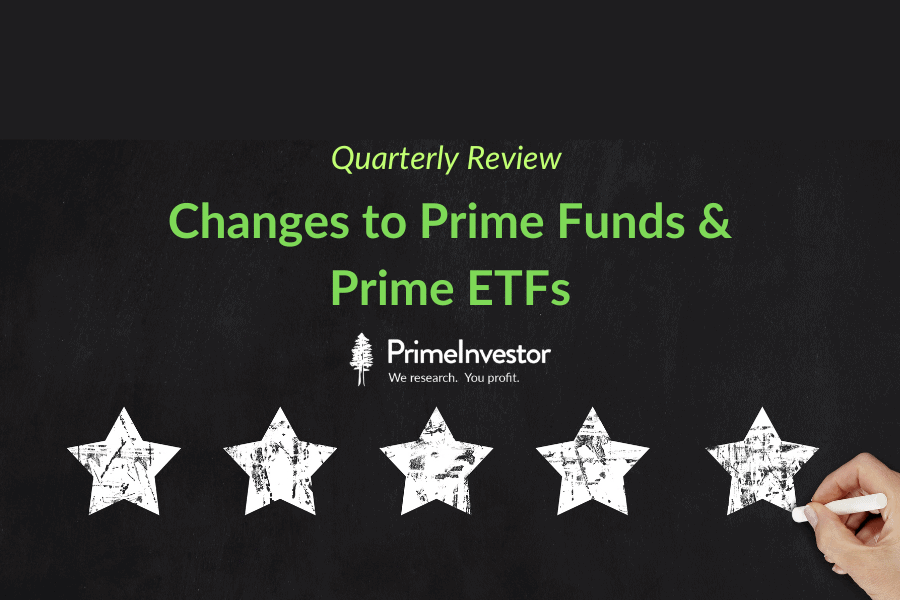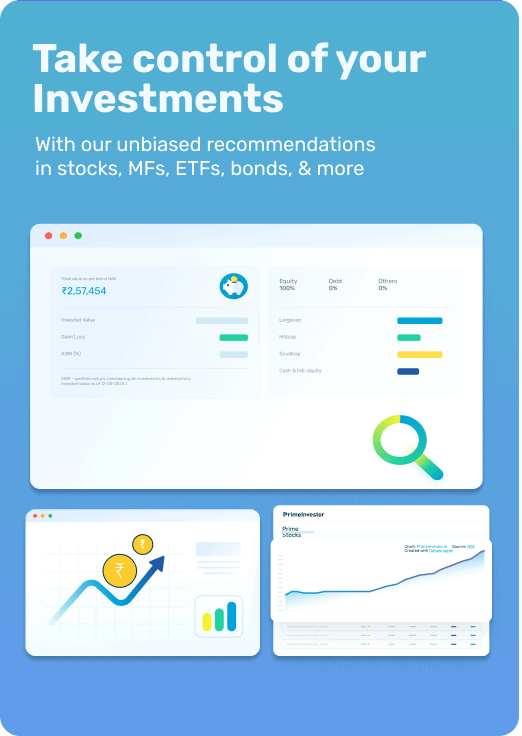Prime Funds is our list of recommendations in equity, debt, and hybrid mutual funds that are worth investing in. Prime Funds narrows down your choices from the thousands of funds that there are into a concise list of funds that span different styles. Prime Funds are selected based on performance, portfolios, and investment strategies.
In this review, we have made very few changes in Prime Funds. Please go through the report to stay updated.

About Prime Funds
Prime Funds is our list of best mutual funds across the equity, debt, and hybrid categories. We use Prime Ratings, our fund ratings, as a first filter. We then apply qualitative analysis to arrive at our fund recommendations. Prime Funds is an enduring list of funds that you can use at any time. You will always find a fund to meet any goal you’re looking to meet.
Different categories: Prime Funds are separated into buckets, based on risk level in equity & hybrid funds and timeframe in debt funds. Each of these draws from different SEBI-defined categories. We have classified them in a more user-friendly way than using the several dozens of SEBI categories. We do not go only by Prime Ratings but look at other factors as well to narrow the list and make the choices easy for you.
Different styles: In Prime Funds, we’ve aimed at providing funds that follow different strategies for you to mix styles and diversify your portfolio with ease. The ‘Why this fund’ for each Prime Fund will brief its strategy, why we picked it, and how to use it in your portfolio.
Direct plans: We have specifically given the direct plans in Prime Funds. If you wish to know whether it is ok for you to use the regular plan of the fund, check our Portfolio Review Pro tool periodically to know if you are with expensive regular plans.
Quarterly review: Our aim in reviewing the Prime Funds list every quarter is to ensure that we don’t miss any good opportunities that are coming up and we are not holding on to funds that are slipping. When we remove funds from the Prime Funds list, we tell you exactly what to do if you have invested in these funds. Funds we remove do not immediately call for a sell – it is just that they have slipped in performance marginally or there are better alternatives now. Unless our review tool says such funds are a ‘sell’, you can hold them (refer to our article on when to sell funds)
Using Prime Funds: You don’t need to hold every Prime Fund nor add any new fund we introduce to the list. Unless it fits your overall portfolio/strategy, or there is something lacking, there is little need for you to go on adding funds. Our idea of covering them in detail through some of our weekly calls is to let you know the strategy, style, and suitability in different portfolios. It is not a specific call to buy right away, unless we mention that it is a ‘tactical’ or ‘timing’ call. If you need to build a portfolio using Prime Funds, use our Build Your Own portfolio tool to make this easy for you.
Equity funds
Markets surged in the final leg of 2023; the last quarter alone saw the Nifty adding close to 2200 points. A return of sentiment in US markets, ebbing concerns over oil prices and a wider conflagration of the Israel-Hamas conflict, and State elections pointing to continuity at the Centre in the general elections all set markets roaring. Foreign institutional flow was strong along with domestic flows. The midcap and smallcap segments continued on a tear, with the indices gaining 12% and 14% respectively in just the Oct-Dec 2023 period alone.
For equity funds, it was a tale of differences. Several large-cap funds have been coming out strong with the broad-basing of the rally. On the other hand, the quarter saw funds from the midcap and smallcap basket falling heavily behind the indices. with the lower rung of stocks in these two indices rallying sharply, funds have stayed away from these riskier bets.
The current euphoria in the market is also making us cautious in gauging fund performance. There is also in several categories, a wide difference between performance. We would prefer to watch how markets overall are trending especially in the run up to elections before taking calls.
We have made just two changes in this quarter’s review in equity Prime Funds.
Equity – Moderate: Passive
We have no changes in the Active set in Equity – Moderate. In the Equity – Moderate: Passive set of Prime Funds, we have added one fund – Nippon India Nifty 50 Value 20. This index fund that tracks the Nifty 50 Value 20 index, which is a factor index that picks stocks from the Nifty 50 based on value parameters. These are return on capital employed and dividend yield (higher the better), price-to-earnings and price-to-book (lower the better). Stocks are scored on these metrics and the top scores make it to the index.
The index’s current sector and construct augur well for performance. The metrics help pick cash-rich, high-quality companies that could also help contain volatility. The Nifty 50 Value 20 beats the Nifty 50 index steadily over rolling 1-year and 3-year periods, as well as large-cap funds. The index itself also has a good history of nearly 10 years of real-time index levels.
The index fund is suitable for any investor’s long-term portfolio as part of the moderate risk component. It can be held even if you hold large-cap funds or Nifty/Sensex index funds. It additionally complements growth-oriented funds in your portfolio.
Equity – Aggressive: Active
There are a few points worth nothing in this segment.
- As mentioned above, midcap and small cap funds have been lagging their benchmark indices. Midcap funds have been more sedate performers compared to the index for a couple of quarters now – which we noted in our September 2023 review.
- But an emerging trend now is smallcap funds also falling behind the Nifty Smallcap 250 when they were comfortable outperformers earlier. With funds tending towards more quality companies and diffused allocations, the sharp rally in the tail end of the Nifty Smallcap 250 index where stocks have shot up 30-100%, have caused smallcap funds to miss the rally.
- We see otherwise consistent mid and small-cap funds (we have written about our Prime Midcap fund underperformance in earlier review and hence not getting into details) underperforming both their benchmark and category for 2 reasons: one, the benchmark is laden with stocks that mutual funds will not enter (poor quality stocks, especially in the small-cap index). Such stocks have seen a massive rally in this market. Two, funds that have been laggards for long have suddenly shot up, pushing these consistent performers down and making them look poorer than category.
- We have seen this play out in earlier bull markets too and hence at this juncture, we are not too worried about some of our underperformers in this segment. In this scenario of euphoric moves, it would be prudent to be cautious about stock-picking and not chase after returns. Quality funds in the mid and smallcap categories also score in containing downsides during corrections, which takes more importance at this juncture in markets.
In this quarter, we have made only one change. We are removing PGIM India Flexicap. This is a fund we have been watching for 2 quarters now. We had retained it because the underperformance at the time was not steep, long-term returns were still holding up against peers and benchmark, and because we were watching the portfolio changes that its new fund manager was undertaking.
However, performance has not showed signs of improving and now long-term returns have also begun to lag. The portfolio top weights are towards large-cap banks, energy, and IT which can take time to rally and push fund returns. Weights to sectors such as banking has also gone up.
While these may eventually help, the deepening current underperformance may make it harder for the fund to recover. We have therefore pulled it out of Prime Funds to prevent an opportunity loss. Stop fresh SIPs in the fund if any. Hold all investments made so far and do not exit.
In this Prime Funds set, we wish to make a mention of SBI Smallcap fund’s performance. This smallcap fund has been well behind both peer smallcap funds and the Nifty Smallcap 250 index, and by a hefty margin.
A big contributor to this underperformance is the fund’s shift to cash; the fund has held close to 10% in cash for the past few months. This, when the segment was rallying, has weighed on returns. The conservative approach at this stage in the markets may be a prudent move and will also leave the fund with deployable cash in the event of a correction. The fund has otherwise been adept at capturing upsides during rallies and has been an above-average performer in the long-term.
Hybrid funds
For aggressive hybrid funds, the broad-basing of the market rally has seen many of them beat the benchmark Nifty Hybrid Aggressive 65-35 index. Several funds also held mid-and-smallcap stocks that have further fuelled their returns. As with equity funds, we are wary giving too much weight to the current performance and prefer to retain steady consistent performers even if they are not the current chart-toppers.
Hybrid – Moderate
In this review, we are removing Edelweiss Balanced Advantage from the Prime Funds list. This fund is among the most aggressive in the balanced advantage category, tending to keep most of the equity exposure unhedged during strong market up-moves. However, despite the higher equity exposure the fund has dropped behind the category average - which includes both conservative and aggressive funds - or been very close to it. Given its strategy and therefore the higher volatility, a better outperformance would typically be warranted. Other aggressive funds have managed better returns.
For these reasons, we are pulling the fund out. Hold all investments made so far and do not exit. For fresh SIPs, consider HDFC Balanced Advantage or ICICI Prudential Equity & Debt from this set.
Debt funds
In debt markets, it is unlikely that there will be any further rate hikes. However, interest rates can remain in the pause mode for a good while; the 10-year gilt yields have largely been rangebound. Short-term market rates have, however, inched up. As a result, both short-maturity funds and long-maturity funds have seen similar return patterns but overall, debt fund returns have cemented a recovery from their long slump. We will issue a detailed debt outlook later this month and alert you to strategies in both debt funds and other bonds over the coming quarters as opportunities arise.
For this quarter, we have made no changes to our debt fund recommendations. The funds we have across the timeframe buckets are all the above-average performers in the category and there are no contenders to replace these.
Prime ETFs
Prime ETFs is our list of recommended ETFs in equity, debt, and gold. We look at multiple factors to draw up this list, ranging from short-term and long-term tracking error, expense ratio, trading volumes and usefulness of the index in a portfolio.
For this quarter, we have made no changes to our ETF recommendations. Our ETF recommendations are spread across broad-market and sector opportunities, and we see no ETF that would be a good addition to a long-term portfolio, and that also has reasonable trading volumes.
You can find the full Prime Funds list here.
You can find the full Prime ETFs list here.
Check our past quarterly reviews here:
Changes to Prime Funds and ETFs for the quarter ending September 2023
Changes to Prime Funds and ETFs for the quarter ending June 2023
Changes to Prime Funds and ETFs for the quarter ending March 2023






15 thoughts on “Quarterly review – Changes to Prime Funds & Prime ETFs”
why there is no review on uti silver etf
krishnaraj ved
We do not have a view on silver as a commodity. In general, you can understand about what drives silver prices here: https://www.primeinvestor.in/do-you-really-need-silver-etfs-in-your-portfolio/ – thanks, Bhavana
Dear Prime team,
Over past few yrs, we have invested in Axis Bluechip(ABC) & Midcap(AMC). Is it prudent to SELL both these funds, factoring in tax implications, if one has substantial holding. Axis LTE is a clear sell due to underperformance. Has that crept into ABC & AMC. Feel cheated by a fund house, backed by a leading bank. Are they overnight operators? Question is SWP or Full Exit (Panic Sell !). Kindly advise. Thanks.
Please check our Portfolio review rpo tool or the MF review tool (old style). Our call on the funds are what is stated. Would be too harsh to say fly by night operators. Since the fund house had an incidence of insider trading by a dealer, there was significant outflows. Besides, their ‘growth’ strategy did not pay off as value took over post 2020. There is no need for any panic sell. You can do based on tax implications. Vidya
Hi,
To build a MF portfolio, I need to invest in 2 active Mid Cap funds. In the Equity – Aggressive Prime Funds list, there are 2 Mid Cap active funds recommended: Kotak Emerging Equity fund and Mahindra Manulife Mid Cap fund. I’ll invest in Kotak Emerging Equity fund, but based on my little analysis, I find Mahindra Manulife Midcap fund to be more volatile. From the other list, there are Buy recommendations in: HDFC Midcap Opportunities, Motilal Oswal Midcap fund, Nippon India Growth fund, Mirae Asset Midcap, SBI Midcap fund and Quant Midcap fund. So, from these other active funds under the Buy list, which another fund will Prime Investor team recommend investing or start a SIP?
Please recommend. I do not want to invest in Passive Midcap fund.
Regards,
Alpesh Dudhwala
We’re not saying you have to invest only in Kotak Emerging Equity 🙂 The only reason we have called out this fund in this review is because we wanted to discuss its performance and of mid-cap funds in general. You absolutely can go with Mahindra Manulife Midcap for your midcap exposure. – thanks, Bhavana
Hi Bhavana,
Thanks for your reply. Actually, I wanted to know which other active Mid cap fund (from the Prime Buy list), Prime Investor team will recommend apart from these 2 funds. If you can reply, then it will help.
Regards,
Alpesh Dudhwala
Sorry for the delay in response; please write to us if you have any specific queries on our recommendations because we’re far more responsive there than in comments 🙂 You can go with HDFC Midcap Opportunities or Nippon India Growth – thanks, Bhavana
Thanks, Bhavana, for the inputs. This helps.
Could not find the review of active funds. Any other suggestions will follow?
There is no separate review of active and passive funds in Prime Funds. They all form part of Prime Funds and are reviewed together. The changes this quarter are minimal and all changes made are explained in the post above. – Bhavana
what about Arbitrage Funds ? you think it’s a good time to enter ? regds
Arbitrage funds are not a timing call; because they hedge their portfolio entirely, they are usually low-risk and are not influenced by market timing. Tax brackets have a bigger role to play here than market levels. Please read this article. – thanks, Bhavana
Almost most of the Funds of Can robeco( ae not performing well?,can you review them. what to with them.
Most Canara Robeco funds follow a growth-style strategy, which have been underperformers in this market. Please use the new Portfolio Review Pro for individual buy/sell/hold calls on funds you hold (or the old MF Review Tool). We continue to retain Can Robeco Flexicap in our Prime Funds list. – thanks, Bhavana
Comments are closed.